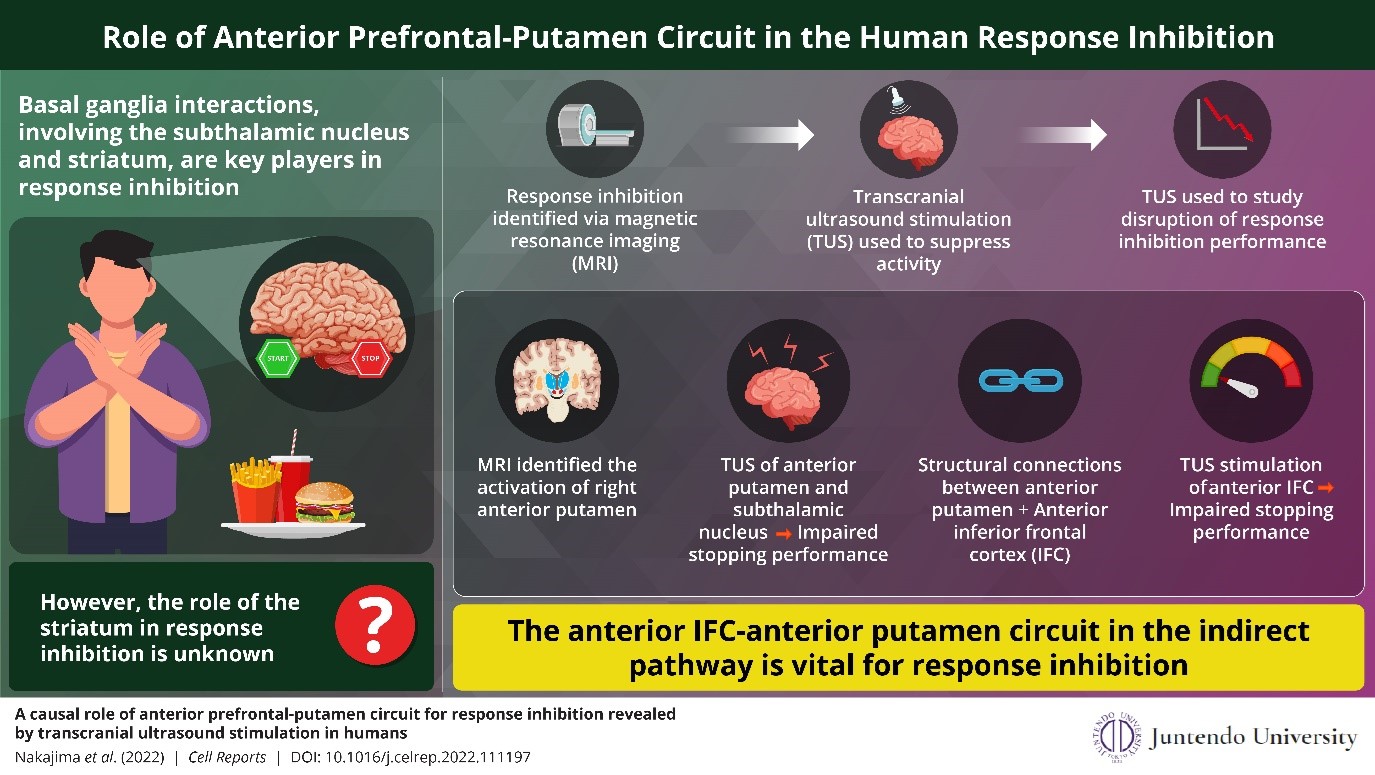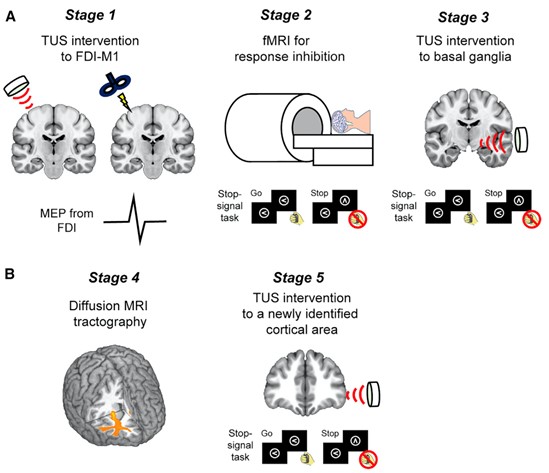Oct. 21, Fri, 2022
Topics
>RESEARCH
Revealed: Anterior Prefrontal-Putamen Circuit Essential to Response Inhibition in Humans
Scientists leverage transcranial ultrasound stimulation to confirm the anterior prefrontal-putamen circuit’s role in response inhibition
Stopping an already initiated but inappropriate response is critical to adaptive behavior in humans, and a brain circuit involving the inferior frontal cortex, the presupplementary motor area, and the subthalamic nucleus in the right hemisphere is important to this response inhibition. The striatum is linked to inhibitory control, but its exact role is unknown. In this study, scientists from Juntendo University School of Medicine verify how the prefrontal-striatal indirect pathway contributes to the stopping response.


The prefrontal-subthalamic neural circuit within the human brain is responsible for stopping inappropriate responses. The striatum in the brain is the main route of direct or excitatory and indirect or inhibitory signals, and this indirect pathway is thought to serve as an alternative stopping mechanism in humans. However, we do not have a clear understanding of how stopping is managed by the prefrontal-striatal indirect pathway.
Now a group of researchers, under the guidance of Dr. Takahiro Osada at Juntendo University School of Medicine, explains the mechanism of the prefrontal-striatal indirect pathway. The researchers have published their findings in volume 40 issue 7 of the journal Cell Reports on August 16, 2022. “We have found a new neural network in the brain that is involved in inhibiting inappropriate responses. This work will shed light on the disordered processes curtailing movement following injury and may even be relevant to managing neuropsychiatric disorders” says Dr. Osada, highlighting the significance of the study.
The researchers leveraged low-intensity transcranial ultrasound stimulation (TUS) to probe stopping responses in the basal ganglia region of the human brain. While neuroimaging studies have previously detected activation within the striatum during response inhibition studies, specific regions in this area could not be pinpointed. TUS is advantageous as the technology allows for non-invasive stimulation of deep brain structures with high spatial accuracy down to a few millimeters.
The team first used functional magnetic resonance imaging (fMRI) to visualize which regions of the basal ganglia that were being activated during this response inhibition. After this, responses within the basal ganglia were stimulated with TUS to examine the disruption of response inhibition performance. The researchers then used diffusion MRI analysis to see if the cerebrocortical region of the brain could function as a counterpart of the striatum. Finally, the team used TUS to understand how essential the cortical counterpart was during response inhibition.
The fMRI results confirmed there was activity in the right anterior putamen during response inhibition. Importantly, TUS directed at both the anterior putamen and subthalamic nucleus regions resulted in significantly impaired stopping performance in test subjects. “We were also able to identify a prominent linkage between the anterior putamen and the right anterior inferior frontal cortex (IFC). When we directed TUS at the right anterior IFC, stopping performance was once again significantly impaired,”elaborates Dr. Osada.
The group is confident the findings will further research exploring neural mechanisms of response inhibition given they identified the role of the anterior IFC-anterior putamen circuit–a new cortical-basal network–in inhibiting inappropriate responses. This is promising as it throws open the door to not merely examining individual regions of the brain but conducting experiments at the whole brain level.
But what are the broader implications for the team’s findings? Dr. Osada concludes, “I firmly believe this research can help us develop better artificial intelligence as we gain insight into brain functions using tools like TUS and fMRI. Dysfunction of the cortical-basal ganglia network is tied to neuropsychiatric disorders and there is much to be uncovered using our methodology in terms of the pathophysiological mechanisms behind these conditions.”
 Experimental setup to suppress brain activity and explore the basal ganglia regions involved in the response inhibition response
Experimental setup to suppress brain activity and explore the basal ganglia regions involved in the response inhibition responseTranscranial ultrasound stimulation was used to probe stopping responses in the basal ganglia region of the human brain
Credit: Takahiro Osada of Juntendo University Graduate School of Medicine
License type: Original content
Reference
| Authors | Koji Nakajima,1,2 Takahiro Osada,1 Akitoshi Ogawa,1 Masaki Tanaka,1 Satoshi Oka,1 Koji Kamagata,3 Shigeki Aoki,3
Yasushi Oshima,2 Sakae Tanaka,2 and Seiki Konishi1,4,5,6 |
| Title of original paper | A causal role of anterior prefrontal-putamen circuit for response inhibition revealed by transcranial ultrasound stimulation in humans |
| Journal | Cell Reports |
| DOI | https://doi.org/10.1016/j.celrep.2022.111197 |
| Affiliations | 1Department of Neurophysiology, Juntendo University School of Medicine, 2-1-1 Hongo, Bunkyo-ku, Tokyo 113-8421, Japan
2Department of Orthopaedic Surgery, The University of Tokyo School of Medicine, 7-3-1 Hongo, Bunkyo-ku, Tokyo 113-0033, Japan 3Department of Radiology, Juntendo University School of Medicine, 2-1-1 Hongo, Bunkyo-ku, Tokyo 113-8421, Japan 4Research Institute for Diseases of Old Age, Juntendo University School of Medicine, 2-1-1 Hongo, Bunkyo-ku, Tokyo 113-8421, Japan 5Sportology Center, Juntendo University School of Medicine, 2-1-1 Hongo, Bunkyo-ku, Tokyo 113-8421, Japan 6Advanced Research Institute for Health Science, Juntendo University School of Medicine, 2-1-1 Hongo, Bunkyo-ku, Tokyo 113-8421, Japan |
About Associate Professor Takahiro Osada
Dr. Takahiro Osada is an Associate Professor in the Department of Neurophysiology at Juntendo University School of Medicine. He received his PhD in 2007 from the University of Tokyo. His research interests span the use of neuroimaging to study human cognitive
functions and the autonomic nervous system. His lab aims to identify task-related brain areas and reveal neural circuit mechanisms that achieve higher cognitive functions. He has authored 28 peer reviewed articles since 2004 and received the Promotion
Award for Young Scientists from The Physiological Society of Japan in 2022.